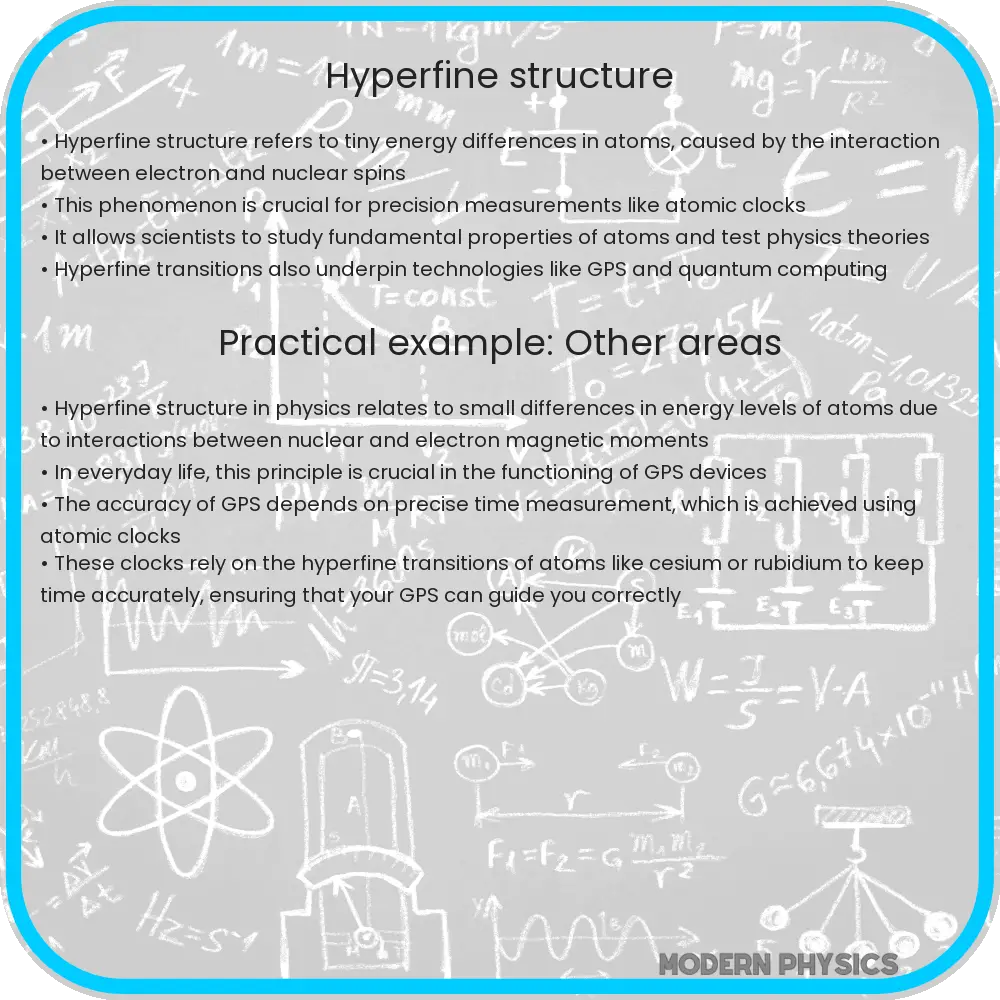Hyperfine structure in atomic physics refers to small corrections in atomic energy levels due to electron-nucleus interactions, impacting fields from quantum computing to astronomy.

Understanding Hyperfine Structure in Atomic Physics
The concept of hyperfine structure in atomic physics may seem daunting at first, but it is crucial for understanding how atoms interact with electromagnetic fields and with each other. Hyperfine structure refers to a set of small corrections to the energy levels of an atom’s electrons, which result from interactions beyond those explained by the basic model of electron orbitals. These small but significant interactions include the magnetic dipole interaction between the electrons and the nucleus, and the electric quadrupole interaction if the nucleus has a non-spherical charge distribution.
To dive deeper, let us consider the magnetic dipole interaction, which is the most dominant contributor to the hyperfine structure. This interaction is between the magnetic moment of the nucleus and that of the electrons. The magnetic moment of a nucleus is primarily due to the spin of its protons and neutrons, which are inherently magnetic due to their charge and spin properties. Since the electrons are also spinning charged particles, they too generate a magnetic field. When these magnetic fields interact, they result in slight shifts in the energy states of the electrons.
The energy shift can be quantified by the hyperfine splitting equation:
Ehf = A * I * J
Here, Ehf is the hyperfine energy, A is the magnetic dipole constant, I is the nuclear spin, and J is the total electronic angular momentum. This equation highlights how the characteristics of both the nucleus and the electron cloud contribute to the hyperfine structure.
Applications of Hyperfine Structure
The implications of hyperfine structure are vast and varied across different fields of science and technology. One of the most renowned applications is in the field of atomic clocks, specifically in cesium-based atomic clocks, which are the standard for precision in timekeeping globally.
Atomic clocks operate on the principle of measuring the exact frequency of the transitions between defined levels of the cesium atom. These transitions occur in the microwave spectral region and are exceedingly sensitive to the hyperfine splitting caused by interactions within the cesium atom. The stability and precision of cesium clocks are such that they are used to define the second in the International System of Units (SI).
Another fascinating application is in the field of astronomy. Astronomers use observations of hyperfine transitions, like the famous 21-cm line of neutral hydrogen, to explore and map the structure of galaxies and the broader universe. This line results from the transition associated with the flip in the spin of the hydrogen atom’s electron relative to its proton, an effect accurately described by hyperfine structure theory.
Furthermore, the fundamental understanding of hyperfine interactions aids in quantum computing and precision spectroscopy, enhancing our capacity to manipulate quantum systems and improving our understanding of atomic and molecular phenomena.
In conclusion, while hyperfine structure in atoms involves complex interactions and precise measurements, its understanding is crucial for advancements in technology and science. The ability to manipulate and measure these subtle atomic features opens new realms in precision technologies, helps maintain the synchronization of global time standards, and expands our understanding of the universe.
Further Insights into Hyperfine Interactions
Exploring further, the hyperfine structure not only influences scientific instruments and astronomical measurements but also plays a pivotal role in the field of medical imaging, particularly in techniques like nuclear magnetic resonance (NMR) and magnetic resonance imaging (MRI). These technologies rely on the precise manipulation and detection of the magnetic properties of atoms in human tissues, which are affected by hyperfine interactions. By understanding these interactions, scientists can produce clearer and more accurate images necessary for diagnosis and treatment planning.
Moreover, in the realm of physics, the precise control and understanding of hyperfine structure contribute extensively to experiments in quantum mechanics and particle physics. For instance, studying the hyperfine structure in exotic atoms (like positronium, muonium, etc.) provides insights into fundamental constants and tests the boundaries of theoretical physics.
Educational and Research Perspectives
From an educational perspective, hyperfine structure serves as an excellent example of how quantum mechanics is applicable in real-world contexts. It provides a bridge between theoretical knowledge and practical application, making it an essential component of the physics curriculum in universities around the world.
In research, ongoing advancements in spectroscopic techniques continue to enhance our ability to detect and measure hyperfine interactions with greater precision. This not only refines our understanding of atomic and molecular physics but also pushes the boundaries of what we can achieve with technology engineered at the quantum level.
Conclusion
In summary, the exploration of hyperfine structure extends far beyond its definition, touching the frontiers of timekeeping, astronomy, medical imaging, and fundamental physics. The continued study of these subtle atomic interactions not only enriches our understanding of the universe but also catalyzes innovation in technology that permeates various facets of life. From grounding theoretical concepts in observable phenomena to enhancing the precision of technological devices and systems, hyperfine structure demonstrates the profound interconnectedness of science and technology. It underscores the importance of meticulous study and understanding in pushing the envelope of human knowledge and capability.
